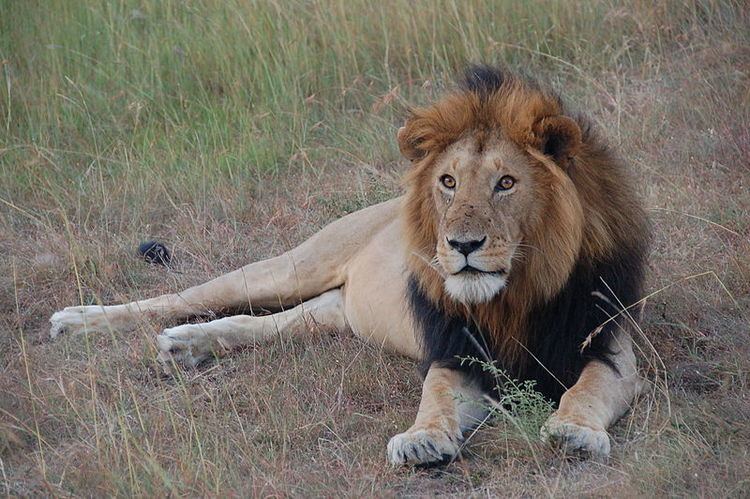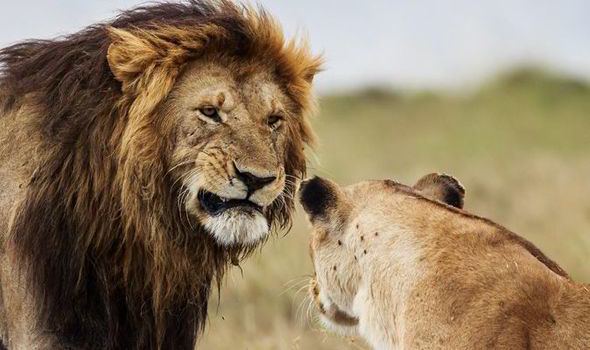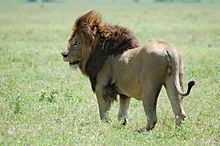Kingdom Animalia Order Carnivora Genus Panthera Height 90 – 110 cm (At Shoulder) Rank Subspecies | Phylum Chordata Family Felidae Scientific name Panthera leo nubica Higher classification Lion | |
 | ||
Mass Male: 140 – 200 kg, Female: 100 – 160 kg Length Male: 2.5 – 3 m, Female: 2.3 – 2.6 m Similar Lion, Roaring cats, West African lion, Southwest African lion, Congo lion | ||
The Masai lion or East African lion (Panthera leo nubica syn. Panthera leo massaica) is a lion subspecies in eastern Africa. The type specimen is described as being from "Nubia". The subspecies includes previously recognized subspecies like massaica, which was initially described from the Tanganyika Territory in Eastern Africa.
Contents

Physical characteristics

Neumann first described the Masai lion as being less cobby with longer legs and less curved backs than other lion subspecies. Males have moderate tufts of hair on the knee joint, and their manes are not full but look like combed backwards.

Male East African lions are generally 2.5–3.0 metres (8.2–9.8 feet) long including the tail. Lionesses are generally smaller, at only 2.3–2.6 metres (7.5–8.5 feet). Lions, male or female, have a shoulder height of 0.9–1.10 metres (3.0–3.6 feet). In weight, males are generally 145–205 kg (320–452 pounds), and females are 100–165 kg (220–364 pounds).

A male near Mount Kenya weighed 272 kg (600 pounds) (Nowell and Jackson, 1996). As such, it would have been heavier than average Southern African lions (Kalahari, Southeast or Southwest African lions) that weighed under 230 kg (510 pounds), but not any exceptionally large Southern African lion that weighed above 272 kilogrammes.

Male Masai lions are known for a great range of mane types. Mane development is related to age: older males have more extensive manes than younger ones; manes continue to grow up to the age of four to five years, long after lions have become sexually mature. Males living in the highlands above 800 m (2,600 ft) altitude develop heavier manes than lions in the more humid and warmer lowlands of eastern and northern Kenya. The latter have scanty manes, or are even completely maneless.
Distribution and habitat

The Masai lion was first described on the basis of observations in northern Uganda, near Kavirondo and in southern Kenya, as well as near Lake Manyara, around Mount Kilimanjaro and in the Tanga Region.
Taxonomic history
The German zoologist Neumann observed lions in Eastern Africa, and proposed the trinomen Felis leo massaica in 1900 based on morphological differences compared with lions from Somalia. His type specimens consist of one male killed near Kibaya, and one female killed at the Gurui River. A decade later, the Swedish zoologist Lönnberg described two lion specimen from the environs of Mount Kilimanjaro under the name of Felis leo sabakiensis that were killed during a Swedish zoological expedition to East Africa. In 1914, the American zoologist Heller described the Abyssinian lion under the name Felis leo roosevelti on the basis of a male lion presented to United States' President Theodore Roosevelt, allegedly from the vicinity of Addis Abeba. In 1939, the American zoologist Allen recognized the trinomen Felis leo massaica as valid, and subordinated F. l. sabakiensis and F. l. roosevelti to this subspecies.
Pocock subordinated lions to the genus Panthera in 1930, when he wrote about Asiatic lions. Ellerman and Morrison-Scott recognized just two lion subspecies, namely the Asiatic P. l. persica and the African P. l. leo, known as the Barbary lion at the time. Various authors recognized between seven and 10 African lion subspecies. Until 2005, some authors considered P. l. massaica as a valid taxon; some considered it synonymous with P. l. nubica described by Blainville in 1843 from Nubia.
Others followed the classification proposed by Ellerman and Morrison-Scott, recognizing two subspecies. Some results of genetic analysis seem to corroborate this assessment, as Eastern and Southern African lions seemed to be rather closely related to each other, forming a clade (Panthera leo melanochaita) different to that Panthera leo leo (Asiatic, North African and West-Central African lions). However, a phenotypic and genetic analysis on Addis Ababa lions showed that they were distinct from other lions.
Conservation
This lion subspecies is relatively common and well protected in large protected areas as the Serengeti-Mara ecosystem.
In captivity
In 2006, eight captive individuals were registered under the name P. l. massaicus from Uganda and Kenya, and 23 as P. l. nubicus from Tanzania by the International Species Information System.
